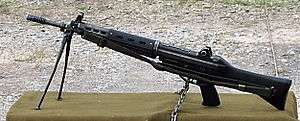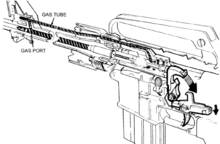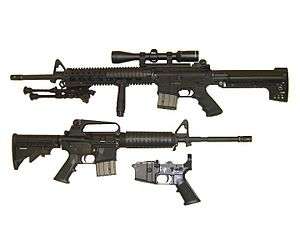AR-15 variant
| AR-15 variant | |
|---|---|
|
AR-15 variants come in many sizes and has many options, depending on the manufacturer. The part shown bottom center is the lower receiver with pistol grip and trigger assembly. | |
| Type | Semi-automatic rifle |
| Place of origin | United States |
| Service history | |
| In service | 1958–present |
| Production history | |
| Designer | Eugene Stoner, Jim Sullivan, Bob Fremont |
| Designed | 1957 |
| Manufacturer | ArmaLite, Colt, Bushmaster, Rock River Arms, Stag Arms, DPMS Panther Arms, Smith & Wesson, Ruger, Remington Arms, Daniel Defense, Olympic Arms and others |
| Variants |
Assault rifle Short-barreled rifle Semi-automatic pistol Designated marksman rifle Carbine Modern Sporting Rifle |
| Specifications | |
| Weight | 2.27 kg–3.9 kg (5.5–8.5 lb) |
| Barrel length |
|
|
| |
| Cartridge | 5.56×45mm NATO and others; see list of AR platform calibers |
| Action |
Direct impingement or Gas Piston[2] / Via a Rotating bolt Blowback on pistol-caliber variants |
| Effective firing range | ~550 metres (600 yd)[3] |
| Feed system |
Detachable or integral magazine, 5.56mm / .223 Remington versions use STANAG magazines Belt feed in some versions |
| Sights | Adjustable front and rear iron sights |

An AR-15 variant refers to a lightweight, intermediate cartridge magazine-fed, air-cooled semi-automatic rifle with a rotating lock bolt, actuated by direct impingement gas-operation or long/short stroke piston operation.
The prototype AR-15 rifle was designed by ArmaLite as a selective fire weapon for military purposes. Armalite sold the design to Colt due to financial difficulties. After some modifications, the rifle eventually became the US Army's M16 rifle. A civilian version was marketed as the Colt AR-15 rifle.
The term "AR-15" signifies "Armalite rifle, design 15".[4] The trademark "AR15" or "AR-15" is registered to Colt, which requires the term to be used only to refer to their products. Colt uses "AR-15" for its semi-automatic civilian rifles and thus many use the term only for Colt AR-15s and clones made by other manufacturers. Other manufacturers make AR-15 clones and variants marketed under separate designations, although these are frequently referred to as AR-15s.
History
AR-15 variants are based on the 7.62 mm AR-10 designed by Eugene Stoner, Robert Fremont and L. James Sullivan of the Fairchild Armalite corporation.[5] The AR-15 was developed as a lighter 5.56 mm version of the AR-10. The "AR" in all ArmaLite pattern firearms simply stands for "ArmaLite Rifle"[6] and can be found on most of the company's firearms: AR-5, a .22 caliber rifle; the AR-7, another .22 caliber; the AR-17 shotgun; the AR-10 rifle; and the AR-24 pistol.[7]

In 1959, ArmaLite sold its rights to the AR-10 and AR-15 to Colt. After a tour by Colt of the Far East, the first sale of AR-15s was made to Malaya on September 30, 1959. Colt manufactured their first 300 AR-15s in December 1959.[8] Colt marketed the AR-15 rifle to various military services around the world. After modifications (most notably the relocation of the charging handle from under the carrying handle to the rear of the receiver), the redesigned rifle was adopted by the United States military as the M16 rifle.
Colt started selling the semi-automatic version of the M16 rifle as the Colt AR-15 for civilian use in 1964 and the term has been used to refer to semiautomatic-only versions of the rifle since then. Colt continued to use the AR-15 trademark for its semi-automatic variants (AR-15, AR-15A2) that were marketed to civilian and law-enforcement customers. The original AR-15 was a very lightweight weapon, weighing less than 6 pounds with empty magazine. Later heavy-barrel versions of the civilian AR-15 can weigh upwards of 8.5 lb.[9]
Only a handful of companies were manufacturing AR-15 type rifles in 1994, but by the twenty first century the number of AR-15 variants and clones had more than doubled.[10] 2016, AR-15-pattern rifles had become controversial in the United States. While the National Rifle Association labeled them as "America's gun", their use in mass shootings has led to a debate between advocates of gun control and gun rights.[11] In Mexico, journalists and government officials call AR-15 variants one of the "weapons of choice" of drug trafficking organizations and other unauthorized users.[12]
_Fig_4-17.png)
Evolution of models
The first civilian version of the AR-15 was the Colt AR-15 Sporter, a .223 Remington semi-automatic variant released in 1964 and issued with 5-round magazines.[13] Prior to the 1986 ban, select-fire rifles were available on the civilian market, including military M16s.
Post-1986 civilian AR-15s support only semi-automatic fire (one shot per trigger pull). They do not have three-round burst or automatic settings; they can only operate as a semi-automatic and are therefore not selective fire weapons (see Modified Civilian below for legally owned full auto AR-15's).
The original design of the Colt mode switch toggles between safe (safety on) and semi-automatic modes, usually marked "SAFE" and "FIRE." Some other manufacturers may mark their rifles with full automatic and three-round mode positions (for collectors and re-enactors) although these settings are for show and have no effect on the function of the rifle.
Modern civilian models are internally different from the M16 and M4, although nearly identical in external appearance. The hammer and trigger mechanisms are of a different design. The firing mechanism (bolt carrier and internal lower receiver) of semi-automatic versions is milled differently, so that they are not interchangeable with M16's or M4's. The design was intended to satisfy United States Bureau of Alcohol, Tobacco, Firearms and Explosives (ATF) requirements that civilian weapons not be "readily convertible" to full-automatic.
Initial sales of the AR-15 were slow, primarily due to its fixed sights and carry handle that made mounting a scope difficult and awkward to use. This changed in the 1990s with the introduction of the flat top upper receiver and new features such as free floating hand guards that increased accuracy.[14]
Modified civilian
Civilian models can no longer be legally modified to full automatic in the United States. Today, the civilian manufacture, sale and possession of post-1986 select-fire AR-15 variants or automatic trigger group components is prohibited, per the Hughes Amendment to the Firearm Owners Protection Act, barring certain exempted groups such as motion picture armorers. However, it is legal to sell templates, tooling and manuals to conduct such conversion. These items are typically marketed as "post-sample" materials for Federal Firearm Licensees. They may be used to manufacture select-fire variants of the AR-15 for sale to law enforcement, military and overseas customers.[15]
In the late 1970s and early 1980s, conversion to full automatic was straightforward, using items such as the "Drop In Auto Sear" or "lightning link". In some cases such conversion required machining the lower receiver with a mill, as well as the substitution of a M16 bolt carrier group.[16][17] Modified weapons did not thereby become able to switch between the three modes of the military model. The latter required a special full automatic fire select mechanism and a modified selector-switch.[16] Some AR-15's made before 1986 were legally converted to M16s by gunsmiths as Form One rifles.[18] Prior to 1986 a full automatic version cost $100 more than the semiautomatic type ($600); after the NFA registry closed in 1986 these full automatic rifles soared in value to over $12,000.[19]
FOPA redefined the definition of a machine gun to include individual components with which a semi-automatic firearm can be converted to full-automatic (based on a 1981 ATF ruling on machine gun parts). Since 1993, the bolt carrier groups used in AR-15 type rifles for civilians have employed additional measures to prevent modification to full auto. Colt AR-15's use a metal alloy shelf to separate the fire control group from the sear, preventing use of full automatic parts.[20]
Components

AR-15 variants are available in a wide range of configurations from a large number of manufacturers. These configurations range from short carbine-length models with features such as adjustable length stocks and optical sights, to complete redesigns for different roles such as designated marksman rifles, varmint rifles and submachine guns. Due to the myriad options, AR-15s have been called "Barbie Dolls for Guys".[21][22][23]
Lower receivers
The lower receiver contains the trigger, disconnect, hammer and fire selector (known as the fire control group. In the U.S. the Bureau of Alcohol, Tobacco, Firearms and Explosives Technology Division designates the lower receiver as "firearms" and requires licensed manufacturers and importers to mark it with a serial number, their name and other markings. BATFE Industry Operations enforce the rules and regulations that determine who is actually in the firearms industry and subject to licensing requirements, regulation and oversight.
Upper receivers
AR-15 variants employ a modular design. Thus one upper receiver can quickly and easily be substituted for another from the aftermarket. Many aftermarket upper receivers are available that incorporate barrels of different weights, lengths and calibers. Available calibers include the .223 Remington, 5.56×45mm NATO, .300 Blackout, 7.62×39mm, 5.45×39mm, .45 ACP, 5.7×28mm, 6.5mm Grendel, 6.8mm Remington SPC,[24] .50 Beowulf and .458 SOCOM.[25]

A side charging upper receiver is offered by some manufacturers. The charging handle can be had in a left side, right side or ambidextrous configuration. The side charging handle is attached to the bolt carrier, making it a reciprocating design. The handle can be used as a forward assist device.[26]
Operating system

Some AR-15 variants use the same mechanism as the original Colt AR-15. This mechanism is often called "direct gas impingement" (DGI), although it differs from prior gas systems.[27]
Other variants replace the DGI operating system with a short stroke/long stroke gas piston system.[28] These rifles usually have modified bolt carriers, gas keys and gas blocks. When fired, DGI systems send high pressure hot gas through the gas tube to the bolt carrier key and into the bolt carrier group. This can heat the bolt carrier group and cause fouling, one of the main design complaints of the original DGI system.[28] Gas piston operating systems alleviate these problems, but can cause issues such as carrier tilt, which can increase bolt fractures. Some variants are completely manually operated.[29]
Rifling
Early models had a 1:14 rate of twist for the original 55 grain (3.6 g) bullets in .223 Remington sporting target and plinking round. This was changed to 1:12 when it was found that in cold weather 1:14 was insufficient to stabilize the bullet would leave a "keyhole" in paper targets. Most recent models have a 1:9 to 1:7 twist rates. The degree to which differing twist rates affect ballistics and terminal performance given varying loads is controversial, although heavier, longer projectiles tend to perform better with faster rifling rates competitive target shooting matches often use .223 Remington rounds as heavy as 77gr Open Tip Match (OTM) with tapered "boattail" to maintain accuracy in various.
Heavy .223rem rounds are impractical for military or hunting applications given the alternatives and are generally limited to competitive target shooting.[30] Additionally, various calibers have their own typical twist rate(s), such as 1:10, 1:11 and 1:12 for 6.8×43mm SPC, 1:10 for 7.62×39mm, 1:9 for the 6.5 Grendel and 1:8 for .300 Blackout. Specialized barrels with gain-twist rifling rates are available for competitive shooters that tune hand loaded target ammunition with powder burn rate, barrel length and bullet weight. This allows long barrelled target rifles to use large powder loads with slow burn rates to keep the pressure in the barrel at its maximum capacity while the round accelerates to extreme velocity while maintaining constant angular momentum for stability. It is a technique borrowed from large bore rifled guns.
Muzzle devices
All .223 rifles use a thread of 1/2-28x, which allows the attachment of devices such as a muzzle brake, flash hider, or suppressor.[31]
Cartridges
Reliability
Firing military 5.56×45mm NATO cartridges may produce dangerously high pressures in civilian chambers designed for the .223 Remington. Excessive pressure may force the primer out of the case into the rifle action. Disassembly may be required to locate and remove the jammed primer.[32]
Unusually sensitive or improperly seated primers may cause a slamfire during loading.[33] Hammer follow malfunction is another potential problem for AR type rifles.
See also
- Assault weapon
- Bushmaster M4 Type Carbine
- Colt Canada C7 rifle
- Comparison of the AK-47 and M16
- Fairchild Aircraft
- M4 carbine
- SR-47
- Table of handgun and rifle cartridges
References
- ↑ "Barreled Upper Assemblies - AR-15". palmettostatearmory.com.
- ↑ "Carbine Length Piston Kit - XLP". adamsarms.net.
- ↑ Saunders, Forrest (June 16, 2016). "Police demonstrate the power of the AR-15 rifle". WWLP. Retrieved 6 July 2016.
- ↑ Armalite - About US. Armalite.com. Retrieved June 18, 2016.
- ↑ "A Historical Review of Armalite" (PDF). ArmaLite, Inc. April 23, 1999. Retrieved July 16, 2008.
- ↑ "1952-1954 - Armalite".
- ↑ Shideler, edited by Dan (2010). The official Gun Digest book of guns & prices 2010 rifles, pistons & shotguns. Iola, Wis.: Krause. ISBN 1440214549.
- ↑ Dockery, Kevin, Future Weapons, Berkley Books, 2007, p. 96.
- ↑ "AR-15 Carbine". Archived from the original on July 31, 2008. Retrieved July 16, 2008.
- ↑ Sweeney, Patrick (30 August 2016). Gunsmithing the AR-15, the Bench Manual. Iola, Wisconsin: F+W Media, Inc. pp. 7–9. ISBN 978-1-4402-4660-9.
- ↑ "AR-15 Inventor’s Family: This Was Meant to Be a Military Weapon" Time magazine. June 16, 2016.
- ↑ Small Arms Survey 2013: Everyday Dangers. Cambridge University Press. 2013. p. 289. ISBN 1107435730. Retrieved 15 September 2016.
- ↑ Bob Hutton & Bob Forker (October 1964). "A Beautiful Marriage: .223 Remington and Colt's AR-15 'Sporter'". Guns & Ammo.
- ↑ Mann, Richard A. (30 April 2014). GunDigest Shooter's Guide to the AR-15. Iola, Wisconsin: Krause Publications. pp. 15–16. ISBN 978-1-4402-3847-5.
- ↑ "Select-Fire (Fully Automatic) conversion information".
- 1 2 "Lightning Link Page". Retrieved May 10, 2009.
- ↑ "Drop in Auto-Sear Page". Retrieved May 10, 2009.
- ↑ Full Auto Colt AR-15 Conversion. July 9, 2009 – via YouTube.
- ↑ Sweeney, Patrick (26 April 2012). Gun Digest Book of the AR-15. Iola, Wisconsin: F+W Media. pp. 259–260. ISBN 978-1-4402-2876-6.
- ↑ Hanks, D.A. (1 September 2004). Workbench AR-15 Project: A Step-by-Step Guide to Building Your Own Legal AR-15 Without Paperwork. Boulder, Colorado: Paladin Press. p. 53. ISBN 978-1-61004-846-0.
- ↑ "Chicago Tribune: Why Assault Rifle Sales are Booming - The Truth About Guns". June 17, 2015.
- ↑ Levings, Darryl (February 2, 2013). "AR-15 rifle more loved — and hated — than ever - Amid the rising call for the rifle to be banned, sales of the "Barbie doll for guys" have soared.". Kansas City Star. Retrieved 10 August 2016.
- ↑ Kyle, Chris (2014). American Gun. William Morrow Paperbacks. p. 252. ISBN 0062242725.
- ↑ U.S. Military Small Arms Ammunition Failures and Solutions, GK Roberts, NDIA Dallas, TX, May 21, 2008 http://www.dtic.mil/ndia/2008Intl/Roberts.pdf
- ↑ Evolution of an AR | Gear | Guns & Ammo Archived September 15, 2011, at the Wayback Machine.. Archives.gunsandammo.com (August 29, 2011). Retrieved on 2011-09-27.
- ↑ LAR Grizzly and Blackwood Arms"Crosshill Technologies XSR-15 Light Weight Side Charging AR-15" on YouTube
- ↑ Lawrence, Erik; Pannone, Mike (2015). AR-15 Handbook. Lawrence Publications. pp. 8–9. ISBN 978-1-941998-58-8.
- 1 2 "6 Facts About AR-15 Gas Impingement Vs. Piston - Gun Digest". June 18, 2014.
- ↑ "TROY Pump Action Rifles". May 20, 2014.
- ↑ Miller, Don. How Good Are Simple Rules For Estimating Rifling Twist, Precision Shooting – June 2009
- ↑ Sweeney, Patrick (2012). Gun Digest Book of the AR-15. Iola, Wisconsin: Gun Digest Books. p. 67. ISBN 978-1-4402-2868-1.
- ↑ "ArmaLite, Inc. Technical Note – 5.56 NATO vs SAAMI .223 Chambers". ArmaLite, Inc. December 4, 2002. Archived from the original on December 17, 2006. Retrieved January 23, 2007.
- ↑ "ArmaLite, Inc. Technical Note — Prevention of Slamfires" (PDF). ArmaLite, Inc. December 26, 1998. Retrieved February 19, 2009.
Bibliography
- Stevens, R. Blake and Edward C. Ezell. The Black Rifle M16 Retrospective. Enhanced second printing. Cobourg, Ontario, Canada: Collector Grade Publications Incorporated, 1994. ISBN 0-88935-115-5.
- Bartocci, Christopher R. Black Rifle II The M16 Into the 21st Century. Cobourg, Ontario, Canada: Collector Grade Publications Incorporated, 2004. ISBN 0-88935-348-4.
| Wikimedia Commons has media related to AR-15. |


